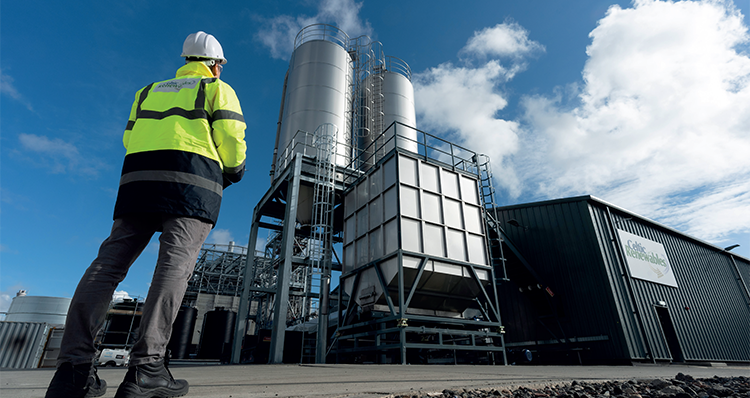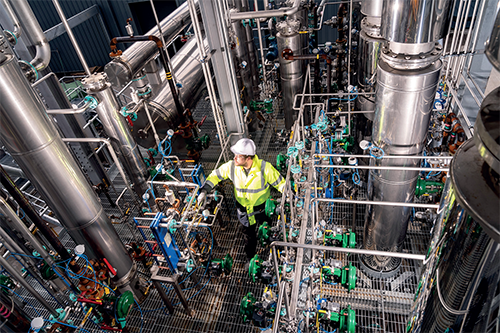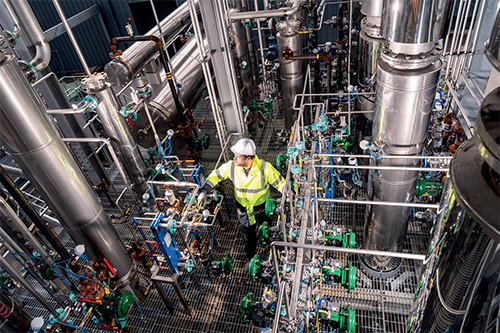
Celtic Renewables
A bright future for bio-chemicals
Having transformed the Acetone-Butanol-Ethanol (ABE) fermentation process to meet the needs of a rapidly growing renewable energy and bio-chemicals market, Celtic Renewables now steps up its operations, and opens its very first manufacturing facility in Caledon Green
By using low-value waste materials to produce high-value, sustainable products, Celtic Renewables offers an environmentally conscious alternative to fossil fuels, and establishes itself as a major player on the road to net zero. Using research produced by Professor Martin Tangney at Edinburgh Napier University’s Bio-fuel Research Centre, Celtic Renewables has worked hard since 2012 to build its first commercial-scale ABE fermentation facility, and promote the increased use of renewable energy.
“Celtic Renewables’ first four or five years were full of milestones; the key was to take those successfully completed laboratory research projects to the next level,” explains Mark Simmers, Celtic Renewables Chief Executive Officer. “We spent that first period of time taking it from the laboratory up to pilot scale. We knew that if our commercial pilot was a success, then we could offer the process on a full industrial manufacturing scale.
“Getting to that point was incredibly important to us, and then the subsequent four to five years was just about getting that pilot proof of concept through, and turning it into an industrial design for our first commercial plant,” he continues.
Taking ABE fermentation from the laboratory to the consumer was no easy feat, as Mark reveals: “We needed to get the funding together to build the plant, which was a very difficult undertaking. Unfortunately for a pre-revenue, early stage biotechnology business that involves significant infrastructure, raising the capital to build a first-of-a-kind plant is really complicated. That being said, we got there in the end, with support from some major investors, Scottish Enterprise (the Economic Development arm of the government) and crowd investors.
“We got the funding together to build plant one in Caledon Green, Grangemouth and that construction is now complete, so we are just going through the final mechanical tests, electrical installation and snagging, things like that. The plant will go into operation at the beginning of 2022, and then we will be making and selling product. Once everything is up and running, we can really get going as a bio-chemical manufacturing business,” he affirms.
The Caledon Green plant is not only Celtic Renewables’ flagship facility; it also represents a significant shift in the energy sector as a whole. “The Caledon Green facility is our showpiece, and our very first plant, so it’s incredibly important to the future of the company, as well as the industry,” Mark confirms.
New facility
The facility is designed to be as sustainable as possible, using the unique process outlined by Professor Martin Tangney. “We use a process called ABE fermentation, which stands for the three primary solvent products: Acetone, Butanol and Ethanol.
“I would say we definitely have a strong intellectual property position at the heart of Celtic Renewables, and involving that scientific patented technology with the industrial manufacturing process is a journey that we have very much embedded into the company ethos,” details Mark.
“ABE fermentation was first invented in 1908, and it proliferated around the world from there; it was the second largest fermentation industry in the world up until the 1960s, when it died out because of the advent of the Saudi Arabian oil fields. It became easier and cheaper to make acetone, butanol and ethanol as co-products of petrochemical or oil and gas production processes, despite the obvious environmental impact of this.
“Although the technology has been around for over a century, no one has ever applied AEB fermentation to waste and residues before. The process was traditionally applied to high value crops, and so what the new Caledon Green plant represents to us is the ability to show the world that ABE fermentation can work as an industrial manufacturing process, using organic waste as the input feed stock rather than high value crops,” he elaborates.
This facility is crucial for the future development of Celtic Renewables, as Mark discusses: “It’s our first plant, which will hopefully become a springboard for us to launch and develop much larger facilities in the future. We have already got half a dozen next-stage project opportunities that we are assessing, and we are looking to start building plant two sometime next year. The design of that one will be based on how we put together the first facility.”
Key relationships
This success would not be possible without the company’s dedicated network of contractor and suppliers – including the likes of Frilli – and their invaluable input. “The supply chain has been absolutely integral to us building our first plant; our various suppliers provided assistance when it came to putting together construction, mechanics and electrical fit-out,” Mark confirms.
“Selecting the right partners to help us go through that journey of evolving the patents into an actual manufacturing process has been key. Developing any project like this takes time; it requires a real sense of partnership between our contractors, our suppliers and us.
“We have got probably a dozen key contractors and suppliers, and then 20-30 other secondary organizations and companies behind that. Having that real sense of partnership and collaborative approach has been critical, as we have navigated the difficulties of the funding, and then the difficulties that have been presented by the pandemic over the last 21 months, together,” he continues.
With the opening of Caledon Green, Celtic Renewables marks the beginning of a long journey towards the establishment of a sustainable future for the energy and chemicals industries, as Mark comments: “We are assessing opportunities to build another five to ten of these plants in the next five years.
“The global demand for bio-based solvents is very significant. We are addressing a butanol market that has an annual demand of 5.5 million tons, and an acetone market that has a demand of six million tons, which, at the moment, is being almost exclusively met from fossil fuel based solvents.
“However, there is a solution, with the drive toward net zero, more and more chemical companies, cosmetic firms, and pharmaceuticals are looking to transition from fossil fuel based solvents to bio-based ones. The critical thing for us is to accelerate the deployment of our technology, and the expansion of the inventory that we are hoping to establish. For me, our success in 2022 will be defined by how quickly we can bring forward those next-stage plant opportunities, and develop the partnerships and joint ventures that will enable us to start developing those projects.”
Renewability revolution
As Mark observes, the conversation surrounding net zero, and sustainable industry, has become increasingly prominent in recent months, following the COP26 summit in Glasgow. Celtic Renewables’ values are at the core of this renewability revolution, as he asserts: “The core tenets of our philosophy are resource efficiency the circular economy and creating carbon emission savings.
“That is at the heart of our commercial approach, and it’s just doing something that has very significant, positive impacts. What was really interesting for me being around Glasgow for the COP26 was seeing how the level of corporate engagement in the net zero journey has really taken off.
“I attended a CBI dinner where the principal speaker was Senator John Kerry, and he very much highlighted the fact that he felt business engagement in the net zero journey had really taken a huge step forward. So, from a Celtic Renewables perspective, it’s really encouraging.”
With trends in the energy sector taking a promising turn, Mark enthuses about the future of Celtic Renewables: “We very much look at the next-stage plants that we want to build as a bio-refineries. The world has a lot of waste residues and biological resources that are currently being under-used or thrown away, and so what we need is a whole series of bio-refineries, where you take in that valuable resource and create value chains through the renewable production of bio-based solvents and other sustainable need products.
“I think it’s important to understand that governments can’t reach net zero on their own. It’s going to require the full commitment of all industries, and the efforts of the public at large. Everyone needs to play their part, and I am feeling much more confident that people are really starting to do just that.
“In the investment sector, across industries, there seems to be a much greater commitment to achieving the targets that were set at COP26, and the announcements around coal and methane are all going to contribute to getting to that 1.5-degree net increase of temperature, so I am positive about it. There is a long way to go, but I think it’s a big step in the right direction,” he concludes.
Celtic Renewables
www.celtic-renewables.com
Services: ABE fermentation plant